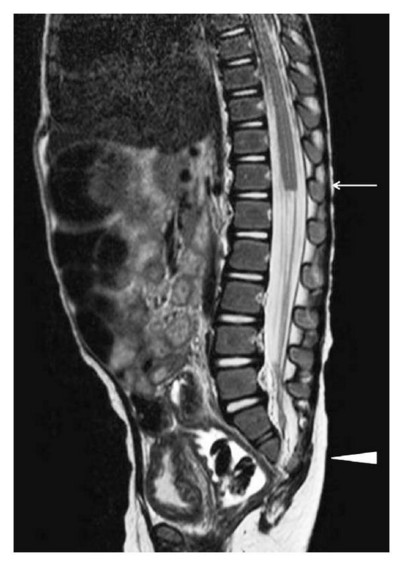(caudal dysplasia, sacral agenesis syndrome)
Rare:1/25,000 to 2/100,000 births, much more common in children born to a diabetic mother. Sex ratio boy/girl = 3/1. Malformations of varying severity of the lower segments of the spine: it ranges from the absence of a few parts of the sacrum to complete agenesis of the sacrum or even lumbar vertebrae with musculoskeletal abnormalities of the lower limbs and pelvis. The pathogenesis is complex (failure of the mesodermic development before the 4th week of gestation) but mutations of the VANGL1 gene (1p13.1) have been identified.
Radiologically, different types (Pang's classification) can be distinguished:
(1) total sacral agenesis with agenesis of some lumbar vertebrae;
(2) total sacral agenesis without damage to the lumbar vertebrae;
(3) partial sacral agenesis (at least S1 is present) or hypoplastic sacrum
(4) hemisacrum
(5) agenesis of the coccyx
However, MRI is necessary to evaluate the spinal cord.
Two main groups are identified:
Group 1:
the spinal conus ends abruptly with a rounded shape ("cigar") and above the usual level; the central medullary canal is sometimes widened or a CSF-filled cyst is located at the end of the spinal conus; these patients have major sacral abnormalities.
Group 2:
the spinal conus is elongated and stretched by a thickened filum terminale or intraspinal lipoma, and ends at a lower level than normal. The neurological side-effects are severe.

thin arrow: rounded terminal conus at T12;
large arrow: sacrum terminated at S2
Many malformations may be associated:imperforate anus, unilateral renal agenesis or other urinary malformations, esophageal atresia (VACTERL, see this term), cleft lip/palate, microcephaly, holoprosencephaly, myelomeningocele.
The Currarino syndrome (see this term) is a form of caudal defect caused by a mutation of the homeobox HLXB9 gene (7q36).
Differential diagnosis: sirenomelia (see this term) where the umbilical artery is unique, the lower limbs are fused or unique, the anus is absent and there are renal malformations.
Anesthetic implications:
according to the comprehensive evaluation of the malformation; as a rule, neuraxial blocks are contraindicated, however a few cases of echoguided lumbar or caudal epidural blocks has been reported
References :
- Cooper MG, Sethna NF.
Epidural analgesia in patients with congenital lumbosacral spinal anomalies.
Anesthesiology. 1991;75: 370-4.
- Yegin A, Hadimioglu N, Sahin N.
Anesthesia in caudal regression syndrome.
Pediatr Anesth 2005;15: 174-5.
- Zaw W, Stone DG.
Caudal regression syndrome in twin pregnancy with type II diabetes.
J Perinatol 2002; 22: 171-4.
- Knight B.
Caudal regression syndrome: a case report.
AANA Journal 2011; 79: 281-2.
- Puneeth KT, Goyal A, Jana M.
High abrupt cord termination : a hallmark of caudal regression syndrome.
BMJ Case Rep 2014 doi : 10.1136/bcr-201-201770
- Ponde VC, Desai AP, Puranik KA, Bosenberg A, Chavan DN.
The utility of ultrasonography in anesthesia management in 3 cases of caudal regression syndrome.
Pediatr Anesth 2021; 31: 362–4
- Visoiu M, Nubani L, Nicolay MD.
Continuous ultrasound-guided sacral intervertebral block for postoperative analgesia in neonates.
Pediatr Anesth 2022 ; 32 :82-4.
Updated: December 2021